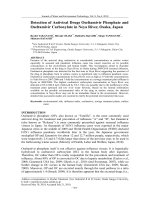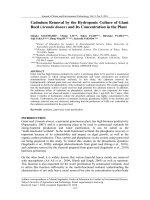- Trang chủ >>
- Khoa Học Tự Nhiên >>
- Vật lý
BORON AND PHOSPHORUS DIFFUSION IN SILICON PRESSURE DEPENDENCE
Bạn đang xem bản rút gọn của tài liệu. Xem và tải ngay bản đầy đủ của tài liệu tại đây (122.94 KB, 5 trang )
Proc. Natl. Conf. Theor. Phys. 36 (2011), pp. 154-158
BORON AND PHOSPHORUS DIFFUSION IN SILICON:
PRESSURE DEPENDENCE
VU VAN HUNG
Hanoi National University of Education, 136 Xuan Thuy Street, Hanoi
PHAN THI THANH HONG
Hanoi Pedagogic University No-2, Xuan Hoa, Phuc Yen, Vinh Phuc
Abstract. The effects of pressure on diffusion of impurities in silicon crystal are investigated by
using the statistical moment method (SMM). Pressure dependence of diffusion coefficient, D, is
characterized by an activation volume, V ∗ . Numerical results for B and P diffusion in silicon are
performed and compared to experimental data showing the good agreement.
I. INTRODUCTION
Dopant diffusion is an elementary physical process in microelectronic device fabrications. As device sizes become smaller and smaller, the role of atomistic dopant diffusion
modeling is becoming more important. B and P are important p-type and n-type dopants
in silicon, and their diffusion properties in silicon have been extensively studied. Both
experimental observations and theoretical calculations indicate that diffusion of B and P
in silicon mediated by an interstitialcy mechanism [1, 2, 3, 4]
A study of the dependence of the atomic diffusivity on pressure(p) can provide
valuable information to help elucidate atomistic diffusion mechanisms.
In the present study we used the moment method in statistical dynamics within
the fourth order moment approximation, to calculated the activation volume, V ∗ , at temperature T and diffusion coefficient, D, of B and P in silicon at temperature T and at
pressure p. We find that both B and P diffusion in silicon via an interstitialcy mechanism.
The diffusivity of B in silicon is enhanced by pressure, while the diffusivity of P in silicon
is retarded by pressure and almost independent of pressure. These results are agreement
with conclusions by Aziz[8] and Zhao[7]. We also compare the calculated results with the
experimental data and previous theoretical calculations.
II. EFFECT OF PRESSURE ON THE DIFFUSION IN SILICON
The pressure-dependence of the diffusivity is characterized by the activation volume,
V [5, 6, 7, 8]
∂lnD(p, T )
= V ∗,
(1)
−kB T
∂p
where kB is the Boltzmann constant and T is the absolute temperature. From Eq. (1) it
is easy obtain the expression of the diffusion coefficient
pV ∗
},
(2)
D(p,T ) = D(0,T ) exp{−
kB T
∗,
BORON AND PHOSPHORUS DIFFUSION IN SILICON...
155
In the equation (2), D(0,T ) , is the diffusion coefficient at a zero pressure and temperature,
T , [9]
Q
D(0,T ) = D0 exp{−
},
(3)
kB T
with Q is the activation energy, and the pre-exponential factor D0 is given by
ω
(4)
D0 = n1 f r12 ,
2π
where n1 denotes the number of the first nearest neighbour; f is the correlation factor; ω
denotes the atomic vibrational frequency of impurity atom in silicon crystal and r1 is the
jump distance at temperature T .
The activation volume, V ∗ , is the sum of the formation volume, V f , and the migration volume, V m , [6]
V ∗ = V f + V m,
(5)
These volume changes are shown schematically in Fig. 1.
Fig.1. Schematic volume changes (see dashed lines) upon
point defect formation and migration for simple vacancy and
interstitialcy mechanisms.
The formation volume, V f , is the volume change in the system upon the formation
of a defect from the free surface in its standard state, it is given by Aziz [6]
V f = ±Ω + V r ,
(6)
where Ω is the atomic volume at temperature T , and the plus sign is for vacancy formation,
and the minus sign is for interstitial formation throughout this paper. The relaxation
volume, V r , is the amount of outward relaxation of the sample surfaces (if the relaxation
is inward, is negative) due to the newly-created point defect.
M.T ang and L.Colombo [11] calculated relaxation volumes for self-diffusion via
interstitialcy and vacancy mechanisms by
r
VI,V
=
3 − l3
lI,V
eq
3 /N
leq
,
(7)
156
VU VAN HUNG, PHAN THI THANH HONG
where lI,V is the box length for interstitial (I) and vacancy (V) defects, respectively; leq is
the original box length (no defect); N is the sum atoms in the box.
The migration volume, V m , is the additional volume change when the defect reaches
the saddle point in its migration path. In interpreting atomistic calculations and experiments in the past, the assumption has been made almost universally that, V m , is negligible
[10]. In the present study, we also assumed that the migration volume was negligible for
the calculation of the activation volume of silicon .
With the aid of Eqs. (3) and (4) permits us to determine the diffusion coefficient,
D(0,T ) , at a zero pressure and temperature, T ,. Using Eqs. (5)-(7) we can calculate
the values of the activation volume, V ∗ , at temperature, T , therefore, from Eq. (2) the
pressure dependence of the diffusion coefficient, D(p,T ) , is determined.
III. NUMERICAL RESULTS AND DISCUSSIONS
We now perform the statistical moment method (SMM) to calculate diffusion coefficient of B and P atoms in silicon via an interstitialcy mechanism at various pressure p.
Using the empirical many-body potentials was developed for silicon [12]
∑
∑
φ=
Uij +
Wijk ,
(8)
i
Uij = ε[(
i
r0
r0 12
) − 2( )6 ],
rij
rij
(9)
(1 + 3 cos θi cos θj cos θk )
,
(10)
(rij rjk rki )3
where rij is the distance betwen the i-th atom and j-th atom in crystal; θi , θj , θk are
the inside angles of a triange to created from three atoms i, j, k; ε, r0 , Z are the potential parameters are taken from ref.12; These parameters are determined so as to fit the
experimental lattice constants and cohesive properties.
Table 1: Potential parameters of the empirical many- body potential for Silicon[12]
Wijk = Z
ε (eV)
2.817
r0 (˚
A)
2.295
Z(eV.˚
A9 )
3484
With the impurity atoms, using the Pak-Doyam pair potential was developed for
boron and phosphorus [13]
{
a(rij + b)4 + c(rij + d)2 + e , rij < r0
φij =
(11)
0,
rij ≥ r0
The parameters(a, b, c, d, e, r0 ) for these potentials are presented in Table 2.
Table 2: Potential parameters of the Pak-Doyam pair potential for B and P [13]
a
φBB (eV ) -0.08772
φP P (eV ) -0.07435
b
-2.17709
-2.60709
c
0.79028
0.64791
d
-2.85849
-3.27885
e
-0.09208
-0.07531
r0 (˚
A)
3.79
4.21
BORON AND PHOSPHORUS DIFFUSION IN SILICON...
157
Using the potential parameters for Si and impurities B and P (Tables 1 and 2),
and our theory in Section II, we obtain the values of the activation volume, V ∗ , and
the diffusion coefficient, D, of B and P atoms in silicon via an interstitialcy mechanism.
The SMM results are summarized in Tables 3 and 4. The SMM calculated results of the
activation volume are in good agreement with the experimental data, and better than
other theoretical methods.
Table 3: Comparison of the SMM calculated results of the activation volume, V ∗ ,
of B and P in silicon with experiments and other calculations.
Atoms
B
P
Expt. and calculations
Expt.[8]
Expt.[14]
Expt.[5]
SMM
GGA (Laudon)[16]
GGA (Sadigh)[15]
LDA (Sadigh)[15]
Expt.[7]
SMM
V ∗ /Ω
-0.16±0.05
-0.17±0.01
-0.125±0.02
-0.17
-0.26
-0.15
-0.11
0.09±0.11
0.04
T(K)
1083
1083
1123
1083
0
0
0
1113
1113
Table 4: The pressure dependence of diffusion coefficient of B and P in silicon.
Atoms T(K) p(GPa) D(p, T )(cm2 /s)
[SMM]
B
1083 0
2.9622 ∗ 10−17
1
3.7662 ∗ 10−17
2
4.7885 ∗ 10−17
3
6.0882 ∗ 10−17
P
1113 0
3.9324 ∗ 10−16
1
3.7255 ∗ 10−16
2
3.5296 ∗ 10−16
logD(cm2 /s)
[SMM]
-16.5284
-16.4241
-16.3198
-16.2155
-15.4053
-15.4288
-15.4523
logD(cm2 /s)
[Expt.]
-16.3872 [8]
-16.2676 [8]
-16.1487 [8]
-16.0269 [8]
-16.6073 [7]
-16.6478 [7]
-16.6883 [7]
In Figs.2 and 3 we show the pressure dependence of diffusion coefficient, D(p,T ) , of
B and P in Si crystal at the temperatures 1083K (for B) and 1113K (for P). It can be
seen in these figures that the diffusion coefficient, D(p,T ) , of B increases with pressure,
while of P decreases with pressure and almost independent of pressure. These results are
agreement with conclusions by Aziz [8] and Zhao [7].
IV. CONCLUSIONS
In this paper we have performed the statistical moment method (SMM) to study
pressure dependence of diffusion coefficient, D(p,T ) , of B and P in silicon obey an interstitialcy mechanism. The SMM calculated results for the activation volume, V ∗ , and
diffusion coefficient, D(p,T ) , are in good agreement with the experimental data.
158
VU VAN HUNG, PHAN THI THANH HONG
-14.8
-13
-15.0
Exp. [8]
-15.2
Exp. [7]
GGA [8]
-14
SMM
SMM
-15
2
log D (cm /s)
-15.6
2
log D (cm /s)
-15.4
-15.8
-16.0
-16
-16.2
-17
-16.4
-16.6
-18
-16.8
0.0
0.5
1.0
1.5
2.0
2.5
3.0
0.0
p (GPa)
0.5
1.0
1.5
2.0
2.5
p (GPa)
Fig.2. pressure dependence of B
diffusion in Si.
Fig.3. pressure dependence of P
diffusion in Si.
REFERENCES
[1] W. Windl, M. M. Bunea, R. Stumpf, S. T. Dunham, M. P. Masquelier, Phys. Rev. Lett. 83 (1999)
4345.
[2] Jianjun Xie, S. P Chen, J. Phys. D: Appl. Phys. 32 (1999) 1252.
[3] J. S. Christensen, H. H. Radamson, A. Yu. Kuznetsov, B. G. Svensson, Appl. Phys. Lett. 82 (2003)
2254.
[4] Xiang-Yang Liu, Wolfgang Windl, K. M. Beardmore, M. P. Masquelier, Appl. Phys. Lett. 82 (2003)
1839.
[5] Y. Zhao, M. J. Aziz, S. Mitha, D. Schiferl, Mat. Res. Soc. Symp. Proc. 442 (1997) 305.
[6] M. J. Aziz, Special issue on Ten Years of Diffuion in Silico (1998).
[7] Y. Zhao, M. J. Aziz, Appl. Phys. Lett. 86 (2005) 141902.
[8] M. J. Aziz, Y. Zhao, Phys. Rev. B 73 (2006) 054101.
[9] Vu Van Hung, Phan Thi Thanh Hong, Bui Van Khue, Proc. Natl. Conf. Theor. Phys. 35 (2010) 73-79.
[10] M. J. Aziz, Appl. Phys. Lett. 70 (1997) 2810.
[11] M. Tang, L. Colombo, J. Zhu, T. Diaz de la Rubia, Phys. Rev. B 55 (1997) 14279.
[12] S. Erkoc, Phys. Reports 278 (1997) 81-88.
[13] Vo Van Hoang, Physica B 348 (2004) 347-352.
[14] Y. Zhao, M. J. Aziz, H. J. Gossmann, S. Mitha, D. Schiferl, Appl. Phys. Lett. 74 (1999) 31.
[15] B. Sadigh, T. J. Lenosky, S. K. Theiss, M. J. Caturla, T. Diaz de la Rubia, M. A. Foad, Phys. Rev.
Lett. 83 (1999) 4341.
[16] M. Laudon, N. N. Carlson, M. P. Masquelier, M. S. Daw, W. Windl, Appl. Phys. Lett. 78 (2001) 201.
Received 30-9-2011.









